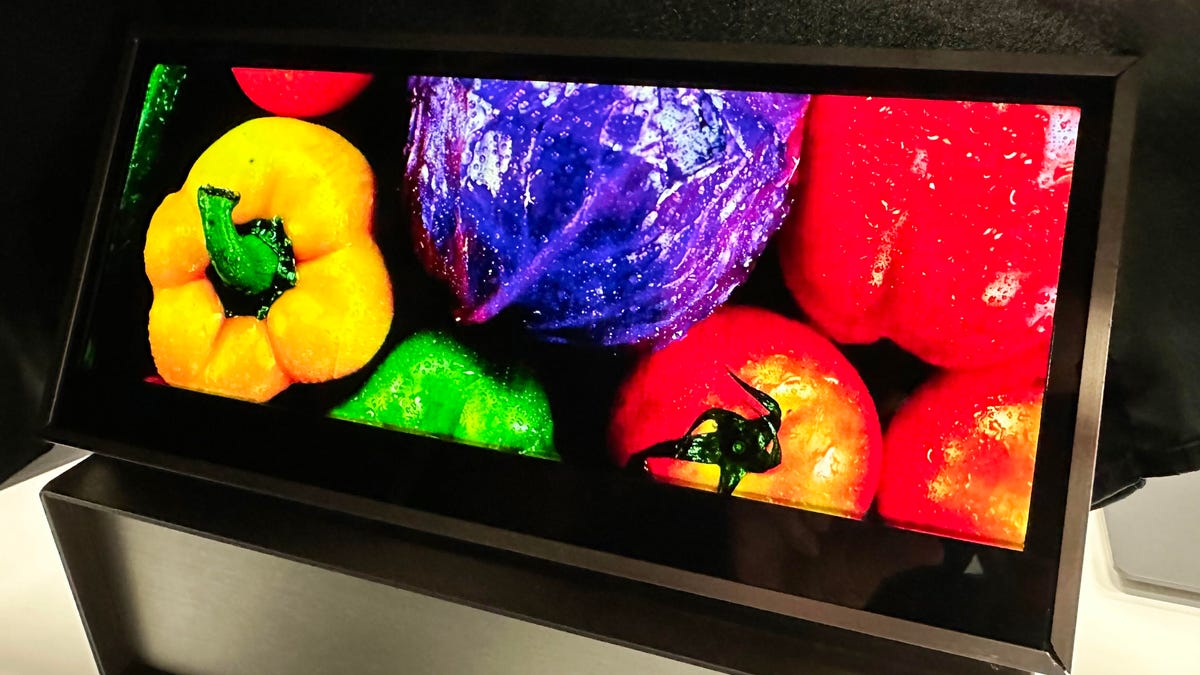 Why You Can Trust CNET
Why You Can Trust CNET The Quantum Dot Powered TV of the Future Takes a Big Step Forward
Sharp and Nanosys have created a prototype 12.3-inch nanoLED screen that could be thinner, brighter and more efficient than OLED.

A 12.3-inch nanoLED prototype built by Sharp.
At last year's CES, I drove all the way to Vegas just to see a prototype of a next-generation display called nanoLED. If you haven't heard of it, you might have heard of the technology it's based on: quantum dots. While the prototype was cool enough for me to drive eight hours over two days, it was still just a tiny prototype. The screen was more Nintendo Switch than home theater size.
Things have moved quickly in the last year. At CES 2024, Nanosys showed off a significantly larger prototype. Not TV sized just yet, but it's a big step.
NanoLED, specifically electroluminescent, aka "direct-view" quantum dots, are even more advanced than current TV tech like LED, LCD or OLED. They boast improved picture quality, energy savings and manufacturing efficiency. And they're theoretically so easy to produce, they could usher in a sci-fi world of screens on everything from eyeglasses to windscreens and windows, similar to transparent OLED and Micro-LED. Here's what we know.
Read more: Best TVs of CES 2024
Direct-view quantum dots grow up
Sharp's prototype has a modest resolution of 1,920x720, though that will certainly be higher in a production model.
At 12.3 inches, the new nanoLED screen is pretty much a usable size. Not for a TV, of course, but definitely for tablets, small laptops and automotive uses. Resolution of the new prototype was a lot higher too, at 1,920x720. Sure, 167 ppi is not mind-blowing resolution, but again, this is very much preproduction.
While perhaps not as interesting as pixels and screen sizes, one of the most important aspects of this prototype is that it was made at atmospheric pressure. The previous prototype required a vacuum chamber. That's a big step towards cost-effective manufacturing.
NanoLED has the potential to be thinner and more efficient than OLED.
Sharp is Nanosys' manufacturing partner and built this prototype. While Sharp has been out of the US TV business since 2015, it didn't abandon the TV market entirely and reacquired its brand name for use in North America in 2019. The company has a lot of firsts in the TV market, including the first LCD TV, all the way back in 1992, and it sold the first 8K TV in 2016. It's also worth noting that it's majority owned by a little company called Hon Hai Precision Industry Company Limited, aka Foxconn, a massive manufacturing company that makes iPhones, Kindles, PlayStations and more.
Some production methods for nanoLED.
What does the future hold? Neither Nanosys nor Sharp are revealing that. It's not difficult to guess we'll see an even larger prototype, maybe even before next CES, probably with even higher resolution. Already Sharp has revealed in a recent white paper that it's been able to achieve 3,994ppi on a silicon wafer, with promising results up to 6,048ppi, which potentially gives it even higher resolution than Apple's much-hyped micro-OLED. TVs don't need that kind of resolution, but it is promising for the technology's scalability. Regardless, it will still be a few years before we see production nanoLEDs, and those first displays will be on smaller devices, but this is a promising tech that seems to be marching steadily towards production.
To whet your appetite, check out our tour of the factory where they make quantum dots.
As well as covering TV and other display tech, Geoff does photo tours of cool museums and locations around the world, including nuclear submarines, massive aircraft carriers, medieval castles, epic 10,000-mile road trips, and more.
He wrote a bestselling sci-fi novel about city-size submarines, and also Budget Travel for Dummies. You can follow him on Instagram and YouTube.

